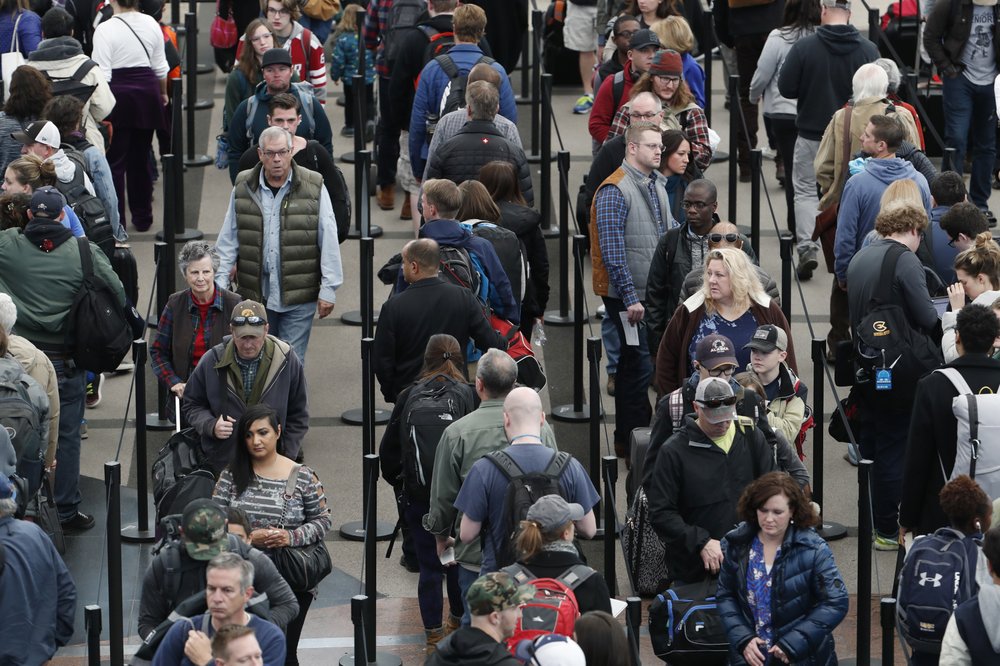
Travelers wait in long lines to pass through a security checkpoint at Denver International Airport in Denver, November 21, 2018. (Photo: AP)
A storm that dumped heavy snow in Colorado and Wyoming forced airlines to cancel hundreds of flights in Denver on Tuesday and has made driving impossible in some parts of the two states just as the busy Thanksgiving week travel period went into high gear.
About 7 inches (18 centimeters) was on the ground at Denver International Airport by morning but more was expected through the afternoon.
About a third of the airport’s average 1,500 daily flights were cancelled, but the airport said in a tweet that many airlines would resume operations later in the morning or early in the afternoon as snow clearing crews worked to keep most runways open.
More than 2 feet (60 centimeters) of snow had fallen in northern Colorado and about a foot (30 centimeters) fell in southern parts of Wyoming by midmorning.
Heavy snow and gusty winds forced the closures of long stretches of Interstates 70 and 76 in Colorado and Interstate 80 in Wyoming, and parts of I-80 were buried under snow drifts of up to 4 feet (1.2) meters.
“We are mindful that this is a holiday travel week and we are working as fast and as quickly as possible to reopen the roads, and we will do that once the roads are safe for travelers,” said Wyoming Department of Transportation spokeswoman Aimee Inama.
Many government offices in the Denver area and in Cheyenne, Wyoming were closed along with colleges and schools not already on holiday break.
The storm system led the National Weather Service to issue blizzard and wintry weather warnings extending into the Great Lakes.
The storm was expected to move into the Plains later Tuesday, bringing high wind and more snow to Minnesota, Wisconsin and upper Michigan.
It could bring another round of snow to the Upper Midwest from Thursday through Saturday, and a chance of snow this weekend in interior New England, said Alex Lamers, a National Weather Service meteorologist.
“That could be a coast-to-coast storm,” he said.
It also could mean disappointment for fans of the larger-than-life balloons flown at Macy’s Thanksgiving Day Parade in New York.
Organizers were preparing for the possibility that they’ll have to ground the iconic balloon characters, given 40-50 mph (64-81 kph) gusts in the forecast. Rules put in place after several people were injured by a balloon years ago require lower altitudes or full removal if sustained winds exceed 23 mph (37 kph) and gusts exceed 34 mph (54 kph). The decision will be made on parade day.
The Minneapolis-St. Paul metropolitan area could see its biggest November snowfall in nearly a decade, and travel is northwestern Wisconsin “is going to be chaotic,” said National Weather Service meteorologist Brent Hewett.
The Minneapolis airport could be hit, but Chicago, with its two big airports, should only see rain from the storm, weather service officials said.
A second storm developing in the Pacific Ocean was expected to hit the West Coast of the US on Tuesday afternoon or evening, bringing snow to the mountains and wind and rain along the coasts of California and Oregon.
Forecasters warned of “difficult to impossible travel conditions” across much of northern Arizona later this week as that storm dumps about 2 feet (0.6 meters) on areas that include Interstate 40.
The National Weather Service’ office in Flagstaff said travel conditions will start to deteriorate Wednesday night, followed by the heaviest snowfall Thursday through Friday morning.
This month, AAA predicted that the number of travelers over a five-day stretch starting Wednesday will be the second-highest, behind only 2005, despite rising costs for a road trip.
At the start of the week, a gallon of regular gas cost $2.59 on average, up 3 cents from a year ago, and rental cars averaged around $75 a day — their highest Thanksgiving price since AAA started keeping track in 1999. Hotel rooms are a mixed bag, with prices falling from last year at highly rated hotels but rising slightly at midrange ones.
People might feel they can afford a trip because of low unemployment, rising household net worth, and the stock market’s continuing strength.
For those who are flying, the airlines expect traffic to be up about 4% from this time last year. Airlines added about 850 flights and 108,000 seats per day on average to handle the increase over last year’s crowds, according to the trade group Airlines for America.
Airline travel before Thanksgiving tends to be spread out over several days, but most people want to go home on Sunday or Monday after the holiday.
American Airlines plans to operate 7,046 flights Sunday, just one less than on Aug. 8, its heaviest schedule this year. In all, 22 of American’s 23 busiest days occurred during the summer vacation season, with this Sunday being the only exception.
“Everybody talks about Thanksgiving being a busy travel time, but summer is Thanksgiving week for the entire summer,” said Ross Feinstein, a spokesman for the airline.


